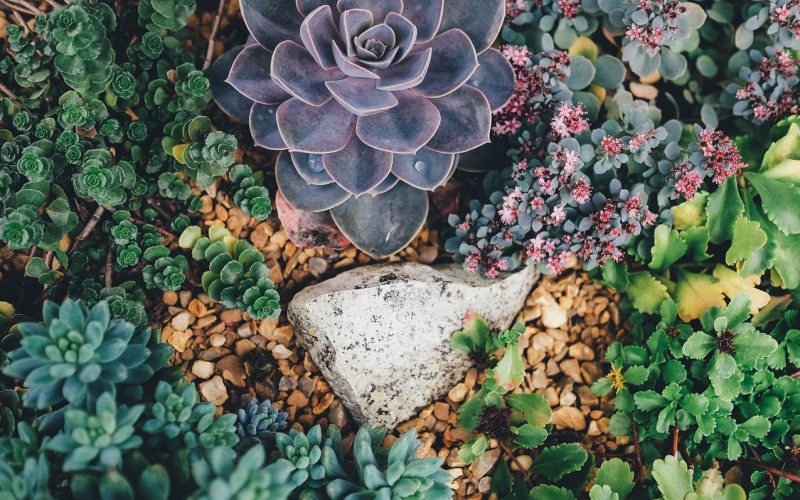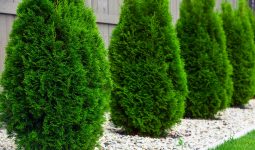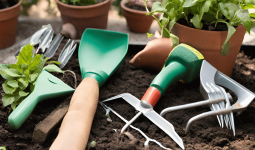Succulents are popular for interior accents and outdoor gardening due to their adaptability, toughness, and classic appearance.
For decorative purposes, succulents may be permanently positioned in the ground or planted immediately into individual pots around your house and yard.
You already know how beautiful succulents are, but you may still be unsure of how to plant Succulents.
Despite their reputation as tough plants that can withstand drought and other adversity, succulents are not nearly as difficult to grow.
Planting succulents is a simple activity that can be completed on your own with a few materials and clear instructions, whether you want to create delicate individual rosettes or elaborate succulent bowls.
Tips to Make Your Succulents Thrive Indoors
Provide Enough Sunlight
Providing an indoor plant with the same light level as it would get in its natural environment is challenging.
Some species, such as those originally from tropical regions, can adapt to the shifting light conditions found inside.
However, putting a plant that requires 12 hours of sunlight daily in an east-facing window may not survive.
If you can’t do that, put it next to a south-facing window. If your windows don’t get much sun, a succulent like an aloe plant is a good alternative.
Water Them Appropriately
More than 9 inches of rain falls yearly in the Chihuahuan Desert, which is little compared to the lush environments most people call home. However, when it rains in the desert, it pours.
If you want your desert-dwelling plant to be happy, attempt to create conditions similar to those in its natural environment. If you want healthy cactus, a steady downpour is what they need, not a slow drip.
Completely submerging a succulent (or any other plant) in water until it drains out of the bottom of the container is the best way to care for it.
Do not water succulents again until the soil is completely dry. Keep the leaves in a dry place to prevent mold growth.
Use the Right Potting Soil
Whether growing ferns or fiddle-leaf figs, your potted plant came with a standard soil mixture. The issue is that regular potting soil isn’t suitable for succulents since they are adapted to survive in one of the harshest habitats on the planet.
A desert-dweller mix of half-potting soil and inorganic perlite should be used after you bring your succulent home.
Most succulents that survive in the high and dry Andes or the broiling bottom lands of Death Valley will grow well in this very good-draining, low-nutrient soil.
Don’t Cram Succulents Together
Cacti and succulents sometimes arrive in little plates that are jam-packed with plants. Succulents are among the few plants that do not thrive in this setting. A good approach to promote the growth of mold and insects is to overcrowd a space.
The second problem is that succulents need regular feeding and watering despite their remarkable ability to thrive on low diets.
They will likely fail since there is too much competition. If your succulents come in a congested bouquet, gently remove each one and place it in its little desert dune.
Make Practical Choices
No matter how lovely their blossoms or alluring their form, not all wild things can be domesticated. Keep to the hardy young ones that won’t bat an eye at making the windowsill their permanent home.
The Crassula and Sansevieria genera are excellent choices if confined to an indoor environment (a.k.a. snake plant). If you’re searching for a thorny houseplant, the Mammillaria cactus is a great option (for its woolly hair, as mentioned above).
How to Plant Succulents?
Adding horticultural grit improves the drainage of the soil before planting succulents. This is one important method for planting succulents. Avoid planting too deeply, as fleshy leaves may perish if they come in contact with moist soil.
Choose unglazed clay pots with plenty of drainage holes on the bottom for planting in containers, and add grit to the soil.
Terracotta pots are porous, so the compost dries up fast after watering, making them ideal for succulents that thrive in drought conditions.
They also rapidly warm up in the sun. Most succulents may be planted in relatively shallow pots since they have fibrous roots.
Another method for planting succulents like agaves is using a compost based on earth since these plants need a heavier compost to attach their roots. When handling spiked agaves, use gloves since the leaves are quite spiky.
How to Plant Succulents Outdoor
Succulents may be grown inside if necessary, but the outdoors is where they flourish. They thrive in natural environments with enough fresh air, good ventilation, and sunlight.
To view the plants at their best, look no further. Here are some things to remember if you want to know how to plant succulents in your yard or outdoor containers.
Ideal Climate
Even while succulents perform best in temperate climates, you can successfully plant succulents outside in just about any place if you give them enough time.
Suppose you live in a region where temperatures often drop below freezing or rise beyond 100 degrees Fahrenheit. In that case, you should plant your succulents in easily portable pots and be ready to transfer them.
Seasonal Care
If you reside in an area with more pronounced seasonal fluctuations, you may need to provide some additional care for your succulents. For example, on cold winter nights, you can cover your succulents with frost cloth to keep them from freezing.
Bring them inside if the temperature drops below freezing during the winter months. If the temperature is expected to reach or exceed 100 degrees Fahrenheit, or if the sun is expected to be more strong than normal, you should relocate them to a shadier spot.
Succulents are known to become dormant or develop slower during the winter months due to shorter days and less sunlight, which is common, as explained by Smith. During the winter, sedums may drop their leaves and die back to the ground.
Sempervivums may enclose their leaves and develop into tight bundles. Both will enjoy new growth in the spring when winter is over.
Soil
Special fertilizer is not necessary how to plant succulents. They can grow in almost all outdoor soils except for those that are compact or clay-like.
If the soil around your succulents is holding on to too much water or moisture, you may add perlite, crushed granite, or soil with quarter-inch-sized particles.
Lighting
When you move succulents purchased online or from a nursery home, they are often kept in shaded places where they must acclimate to their new outdoor environment.
Your outdoor plants may experience sunburn and even death if they are not used to the quantity or intensity of the sun there.
Succulents have sensitive skin. When you bring one home, you must reproduce the plant’s original growth environment.
It should be gradually adapted to the environment where it will flourish.” When you get your plants home, place them in a shaded spot or someplace they may get indirect light exposure.
If you want your plants to ultimately thrive in a place with direct sun exposure, acclimate them early in the spring when the light and temperatures aren’t as intense.
The Most Common Problems of Planting Succulents
Overwatering
Watering should always be done sparingly. If you overwater your plants, they will rot. According to Hong, succulents don’t like to be submerged in water for an extended period. Plants should only be watered after many days of dry soil.
Poor Drainage
The roots of succulents thrive when they can dry out quickly. Your succulents could stay in the water too long and rot or die if you transfer them to pots lacking drainage holes.
Watering with Spray Bottles
These irrigation systems encourage deep, thin roots since water doesn’t penetrate the soil deeply enough.
Irwin explains that for the roots to grow deeply, “you want the water to get down—a spray water bottle can never reach that deep.”
Mold growth may also result through spray bottles, particularly if water is sprayed onto leaves rather than into the ground. Irwin adds, “The bottles also provide a lot of moisture to the top without doing anything for the root.
Spray bottles create dampness, which is not what you want for succulents. Using a pitcher or container, directly spray water over the soil.
Bad Soil
According to Tuttle, the soil is the worst killer of succulents. “Succulents often grow in too-dense soil. It prevents them from drying out soon, which causes the succulents to rot.” These plants thrive on soil with quarter-inch-sized particles that drain fast.
Lack of Lighting
Lack of sunlight will cause succulents to develop etiolation, which results in long, weak stems, gaps between petals, a loss of color, and a slouchy appearance.
If you don’t have an indoor grow light, place them next to a window that gets direct sunlight for at least six hours every day.
Sunburning
While many succulents thrive in direct sunlight, others prefer partial shade or sunlight from the milder morning sun.
If you see black patches on the leaves or a whiteish color, your succulent plant may receive too much sunlight.
Learn to adjust them early in the season or in spring if you want to grow them outside in the hot sun. The scar left by any harm, such as sunburn or scrape, won’t go away, yet the plant may still grow and survive despite the wound.








